
SECOND CHANCES
john cribbs
A HISTORY OF VIOLENCE
page 2
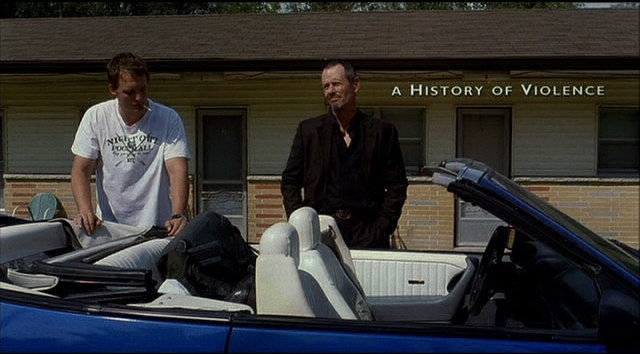
The Second Chance:
Bad news from the onset: I was wrong about the opening scene being any good whatsoever. I remembered thinking it had been successful at setting a seditiously vulgar tone, one that the rest of the movie would not pick up on in the slightest, and came the closest to resembling the kind of careful pacing and shot construction a master director like Cronenberg is capable of. Upon re-examination that just isn't the case: the opening shot's meticulous dolly movement from the back of the hotel to its front office, following two obvious psychopaths as they "check out," is neither a tone setter nor a pace indicator, it's actually as slow and calculated as it is for the sole reason of letting the audience know that the following film will be a very studied examination of the Big Theme the movie will be tackling, specifically - as the opening title informs us - "a history of violence." The ominous duo move at a snail-like pace from their room at the single-floored, off-road motel (a location irrevocably registered as foreboding thanks to Hitchcock's Psycho) sharing banal dialogue about the weather and whether or not they're "fixed for water." The younger crook heads into the reception area which, to the surprise of no one, is littered with corpses. Something I had completely forgotten was the little girl who stumbles upon the bloody aftermath stroking her doll's hair - really? she strokes the doll's hair? - only to become the final victim of this "you guys get it right - bad people kill other people randomly, we're all on the same page about that?" prelude.
As an introduction to the dissertation that is this movie, the opening scene manages to be both portentous and pretentious; "violence exists!" it seems to want to spell out for us. To punctuate that profound revelation, it cuts to a creepy blonde porcelain doll of a little girl waking up screaming about monsters. To move from the "nightmare" scenario of a world where little girls stroking their dolly's heads are ruthlessly gunned down by maniacs to the safety of the bedroom of a similarly-aged girl in middle America where the concept of violent crime is unfathomable is about as subtle a shift as transferring from Kansas to Oz. Just to embellish the laziness of this transition and declare the family environment a violence-free zone, the filmmakers send in the little girl's father to find out what's wrong. He's immediately followed by his son, the girl's big brother, who in turn is joined by a worried mom. This horrible scene was an instant dealbreaker when I saw the film in the theater, but in the context of the heavy-handed prelude it somehow becomes so much worse: it's not only the unforgivable "it was all a dream" twist but the establishment of a reality where life is unrealistically peachy keen and worry-free. Even the filming of the scene, made up of a shot from the girl on the bed to daddy coming in through the door to daddy sitting with the girl to the brother coming through the door etc until the bed is full of caring family members forming a protective circle, is so artless and flat it seems like the director was worried the audience might miss its intention. From a storytelling point of view, this is by far the most unconvincing introduction of characters I've ever seen in a movie. Why on earth would all three family members rush to the aid of this little girl? I can see maybe the dad coming in, and even possibly a bedraggled mother following shortly after to stand in the doorway in show of support for both her little girl and hard-working father of a husband. But under what pretense would the brother come in as well, and why would all three huddle on the bed as if strategizing the best way to diffuse this bad dream situation? The reason is the screenwriter wants us all to know that this is a close American family who are too good to be true, supportive and caring to an absurd level of type. So much so that they, as characters, are completely unbelievable. Tonally, stylistically, and narratively this moment is a disaster...did the little girl really just wake up from that first scene, or is this the actual nightmare? (The fact that the entire concept behind this transition - the first scene of the movie ending with a child threatened by a pair of killers who've murdered everyone else cutting to the second scene of a girl waking up from a nightmare in a safe environment with her loving family coming to her "rescue" which introduces the main character - is so blatantly ripped off from Carl Franklin's One False Move is another tangent worthy of its own paragraph.)
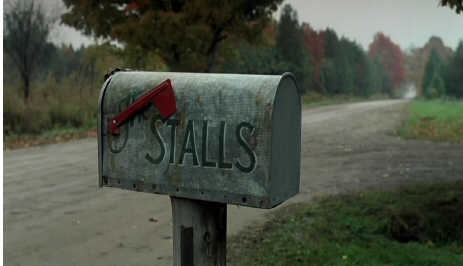 I found this scene to be just as embarrassing the second time around, and somehow even more perplexing. Why this absurdly high level of artificiality? It doesn't stop there: afterwards we're introduced to the rest of the world, a time capsule of small town pleasantness out of a Rockwell painting that looks like a set. But not just a facade built for the purpose of the movie- a set that exists within the film itself, like the population got together to make their home as "small towny" as possible by building mock-ups of good old fashioned shops and adorable eateries.* That is to say, it actually feels so phony as to make me believe it's supposed to be phony in the world of the film. Defenders of the movie would probably say the phony-feel of the town is a good symbol of Viggo's fake identity hidden within this environment, but come on really? Was the town created to shelter
his new, wholesome persona? Is he in the Matrix, or his own existential television series a'la The Truman Show (that would at least explain why every TV network is simultaneously broadcasting his act of heroism later in the movie)? From the handmade mailbox outside the Stalls' mist-enshrouded home to the friendly townfolk who all say "hello" to each other and the abundance of home-baked pie, nothing seems real even though we're now supposed to be in the real world. Watching the movie a second
time I tried to determine if there was a genuine reason behind the way the town is presented - maybe Cronenberg wanted it to look antiquated to make the story seem timeless? - but there's simply no proof of it. Is this the so-called "cinematic representation" of society that Amy Taubin mentioned in her enthusiastic article? Because all movies create "cinematic representations" of the world...so why is this one so aggressively fake?
I found this scene to be just as embarrassing the second time around, and somehow even more perplexing. Why this absurdly high level of artificiality? It doesn't stop there: afterwards we're introduced to the rest of the world, a time capsule of small town pleasantness out of a Rockwell painting that looks like a set. But not just a facade built for the purpose of the movie- a set that exists within the film itself, like the population got together to make their home as "small towny" as possible by building mock-ups of good old fashioned shops and adorable eateries.* That is to say, it actually feels so phony as to make me believe it's supposed to be phony in the world of the film. Defenders of the movie would probably say the phony-feel of the town is a good symbol of Viggo's fake identity hidden within this environment, but come on really? Was the town created to shelter
his new, wholesome persona? Is he in the Matrix, or his own existential television series a'la The Truman Show (that would at least explain why every TV network is simultaneously broadcasting his act of heroism later in the movie)? From the handmade mailbox outside the Stalls' mist-enshrouded home to the friendly townfolk who all say "hello" to each other and the abundance of home-baked pie, nothing seems real even though we're now supposed to be in the real world. Watching the movie a second
time I tried to determine if there was a genuine reason behind the way the town is presented - maybe Cronenberg wanted it to look antiquated to make the story seem timeless? - but there's simply no proof of it. Is this the so-called "cinematic representation" of society that Amy Taubin mentioned in her enthusiastic article? Because all movies create "cinematic representations" of the world...so why is this one so aggressively fake?
The flagrant artificiality of HOV's world is something that works against the serious, scholarly tone of the movie, yet its admirers draw attention to it as if it's not an embarrassingly poor aesthetic decision. In his review that labeled the film a "masterpiece," Jonathan Rosenbaum conceded that "thereís hardly a shot, setting, character, line of dialogue, or piece of action in A History of Violence that canít be seen as some sort of cliche." He goes on to say these aspects never feel like cliches, but they absolutely do (it's remarkable how those who liked the film are quick to point out its obvious flaws and even quicker to defend them). At this point the viewer is forced to consider the filmmaker's intentions. I've long defended David Lynch's waving fireman opening of Blue Velvet, which is a film about surfaces and what's beneath them that plunges its small town characters into a dark fairy tale of viral ugliness lurking behind glossy facades. But Cronenberg's portrayal of the town and its inhabitants is more like the Coen brothers, snarky and satirical, almost a Von Trier-esque parody of middle American values. It's not that Cronenberg doesn't care about his characters the way the Coens don't care about their characters, it's just that through their broad sing-song dialogue they become as hollow and phony as the town, making it impossible to engage them as actual people (or representations of actual people). In this ridiculously constructed world, there's no reason to worry abouy its characters or what their wooden dialogue and cliched actions portend to symbolize. Kingston Falls might have been the same kind of nod-to-audience phony ideal hamlet in Joe Dante's Gremlins, but the characters never registered the least bit false and Dante managed to turn the American notion of nuclear family upside down while maintaining a credible story.**
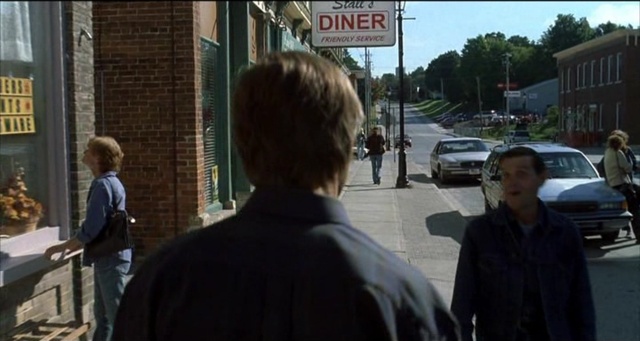
So is it all a joke, like in a Coen brothers film? Is there a polka king poster behind young Jack Stall's bedroom door? The cardboard dialogue, the apparently intentional overacting, the Mayberry exteriors...everything feels tailored to sabotage any attempt at presenting a good old fashioned potboiler, almost as if the director is suddenly ashamed or uneasy with his background as a genre filmmaker. It honestly feels like he's going out of his way to hint at how dumb the very concept of the movie is, which ironically enough only makes the proceedings even more hackneyed than they would be if played straight (see the end of the article for an example of this kind of thing done right). It's so unlike Cronenberg to make apologies through the aesthetic, which is why I'm forced to look for any alternative explanation. If the idea is, the more "real" Tom's true-self becomes, the walls begin to come down and the more authentic the movie feels, then why does the supposedly seedy road lead the character back to Philadelphia and the most unapologetically goofy scene of the entire movie?? Why are the allegedly "dark" moments (the son dishing it out to the bully, the rough sex/rape on the staircase) just as hopelessly trite and corny as the first handful of unwatchably stupid scenes? The film was heralded as the director's most mainstream and accessible to date, but somehow I find a society of warring psychic warriors, reality where teleportation has been invented and the underworld of car crash fetishists all somehow more believably constructed than this faux-one horse town. Was I an idiot for allowing his unironic approach to movies about murderous parthenogentic mutant children and abdominal vaginas work on me? Certain critics had snooty responses to the film to the effect of "it's like a Charles Bronson movie, only smart," or "it's this really deep arty film hiding within a standard thriller" (or, "a gripping, incendiary, casually subversive piece of work that marries pulp watchability with larger concerns," per Kenneth Turan), but what really worries me is that Cronenberg himself feels above the material here and made the terrible choice to make sure the audience knew it.
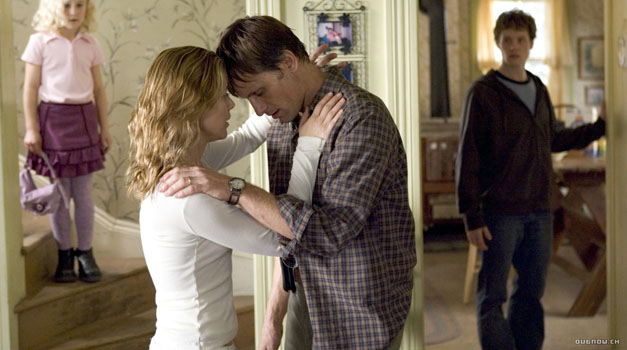
Even back when he was dealing with internal parasites that stimulate uncontrolled sexual desire in their hosts, Cronenberg was better at developing characters than in HOV. The Stall family never advances beyond the assigned roles they're handed in their first scene: Mario Bello as Edie is the supportive and, later, betrayed wife (she's supposed to be a lawyer, but other than a moment where she announces "I picked up a restraining order at court today" like she just got some groceries for the weekend this fact is totally irrelevant). I don't think the little girl has a single line of dialogue throughout the rest of the film. And although Cronenberg added the "role play" sex scene as a quick way to establish the intimacy of the characters, Edie and Viggo Mortensen's Tom Stall seem like strangers from the beginning, maybe because they are both such broad characterisations they barely seem to exist. In The Fly, the tragic relationship between Jeff Goldblum and Geena Davis builds from one scene to another: first it's antagonistic, then professional, then intimate and finally tragic (Molly Haskell once observed its relevance to all marriages in which "he changes, and she doesnít.") I'll come back to the son in a second, but suffice to say he is decisively the most atrocious of the movie's bland cookie-cutter bromides placed inside the narrative only to set up the sentiment: "This is a happy family. Something is about to happen to make them less happy than before."
That something becomes the inciting incident (and I use that "mechanics of screenwriting" jargon only because the script is tailored in such a clumsily traditional way) meant to integrate the movie's Big Thoughts into its ersatz environment. As the opening hotel scene and the introduction of the Stall clan and their idyllic surroundings are meant as contrasting realities - the nightmare and the beautiful American dream - they're obviously destined to converge, at Tom's picturesque diner where the crooks accost Tom's staff and customers before breaking out the guns. The scene itself is really just a riff on Hemingway's "The Killers," the only difference being that instead of intentionally hunting the hidden man the two gunmen inadvertantly unleash one they never knew, and will never know, existed. The set-up itself is interesting, but it's a little far-fetched: what's the duo's plan here, to kill all five people in the middle of the day? Ultimately motivation doesn't matter: these two cartoon villains (ooh he raises his voice, what a psycho!) never had any purpose in the movie other than to get to this point, representing the senseless violence of every shocking act ever to scandalize the nation and reveal the dark underbelly of American society from school shootings to tales of torture at Abu Ghraib. At least that's what the weighty subtext of the film is allegedly meant to suggest, and what critics have beguilingly attributed to the movie.
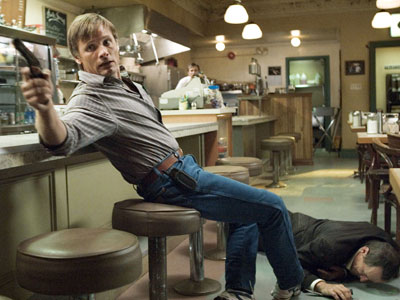 I don't want this to turn into a critique of critics' personal readings of the film, although I honestly feel a large part of my personal bafflement comes from their collective interpretations that were apparently pieced together from fragments scattered all over Broad Street USA. Political, religious and philosophical themes that simply don't exist in the movie have beenthrown at it; among the least substantiated translations are that it's a map of Darwinian evolution, or a dissection of violence in cinema and the audience's reaction to it, or a symbol of the war in Iraq. In his review, Roger Ebert pondered, "Is our peace purchased at the price of violence done elsewhere?" indicating some sort of connection between the film and US foreign policy. Amy Taubin has consistently been on my short list of favorite film writers, but her reading of Edie's non sequitor "You
never lived in Portland?" to her unmasked marital partner as an echo of "You mean you knew there were no weapons of mass destruction in Iraq?" is so random it feels like the kind of needlessly forced association made by moron critics who call every movie to feature a squib effect "Peckinpah-esque" (a term that Violence has naturally been tagged with by many). Tom being labeled a hero for committing a gruesome act of defense that is subsequently considered "good violence"
may have political connotations to it by the same logic that, if you had a straw, you could conceivably fit a pebble through it from one end to the next - it's just not going to resemble a straw when you're done with it. If there are "Iraq" connections to be found, why are the nomadic killers and gangsters from Philadelphia presented as the occupying agencies from out of town? Why isn't Tom given some kind of hero's parade after his courageous act with a giant American flag draping in the background?
Why isn't the military, the president, nay any indication of society outside of Millbrook, Indiana and a bar and mansion in Philadelphia referred to by anyone at all? This isn't a case of not digging deep enough, it's one of writers like Ebert and Taubin burrowing in the wrong direction and then trying to dig their way back up.
I don't want this to turn into a critique of critics' personal readings of the film, although I honestly feel a large part of my personal bafflement comes from their collective interpretations that were apparently pieced together from fragments scattered all over Broad Street USA. Political, religious and philosophical themes that simply don't exist in the movie have beenthrown at it; among the least substantiated translations are that it's a map of Darwinian evolution, or a dissection of violence in cinema and the audience's reaction to it, or a symbol of the war in Iraq. In his review, Roger Ebert pondered, "Is our peace purchased at the price of violence done elsewhere?" indicating some sort of connection between the film and US foreign policy. Amy Taubin has consistently been on my short list of favorite film writers, but her reading of Edie's non sequitor "You
never lived in Portland?" to her unmasked marital partner as an echo of "You mean you knew there were no weapons of mass destruction in Iraq?" is so random it feels like the kind of needlessly forced association made by moron critics who call every movie to feature a squib effect "Peckinpah-esque" (a term that Violence has naturally been tagged with by many). Tom being labeled a hero for committing a gruesome act of defense that is subsequently considered "good violence"
may have political connotations to it by the same logic that, if you had a straw, you could conceivably fit a pebble through it from one end to the next - it's just not going to resemble a straw when you're done with it. If there are "Iraq" connections to be found, why are the nomadic killers and gangsters from Philadelphia presented as the occupying agencies from out of town? Why isn't Tom given some kind of hero's parade after his courageous act with a giant American flag draping in the background?
Why isn't the military, the president, nay any indication of society outside of Millbrook, Indiana and a bar and mansion in Philadelphia referred to by anyone at all? This isn't a case of not digging deep enough, it's one of writers like Ebert and Taubin burrowing in the wrong direction and then trying to dig their way back up.
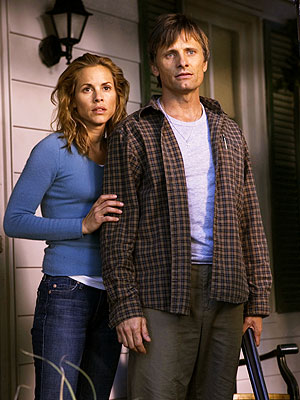 Peter Travers claimed the film "shows how we secretly crave what we publicly condemn." Well what the hell is that in reference to? Is he talking about the sex scene - we all pretend like role-playing with a beautiful woman dressed in a cheerleader's outfit is repulsive when it is in fact awesome? Because he can't mean the violence: do we all really secretlycrave bloodshed? Admittedly, Travers is a writer who lacks the pedigree of an Ebert or talent of a Taubin, but even he should be placed in some kind of critic's jail for unleashing such a generic, unsupported declaration onto the paying public. Trying to form a commentary on the gladitorial arena mentality of moviegoers is clearly not on the film's agenda, unless I missed the couple sitting in the back of the diner munching on popcorn wearing 3-D glasses and hooting in glee as Tom blew the two killers away. The
idea that we cheer for "worthy" violence against oppressors but are terrified at the idea of inherent violent nature inside and where it can lead (again, something that could very thinly be contorted into some sort of political theme) is an interesting concept, but not one that's explored in this movie. We're supposed to cheer for Tom to prevail then, apparently, find ourselves repulsed by the very violence we wished upon these bad men? If so why is the only violence perpetrated in the film against
those who unquestionably deserve it (established killers, threatening gangsters, bratty kids, pompadoured bullies and scene-chewing character actors)? J Hoberman went so far as to call HOV "a successful version of Michael Haneke's audience-bashing Funny Games," but the most provocative scene in Haneke's movie that would be exactly like the diner sequence except the surviving killer manages to find a remote control and "rewind" the hero's successful attempt to turn the tables, thus robbing
the victims and audience of their demand for vengeance, is a deliberate act of subversion by its director depicting violence perpetrated against parties who definitely do not deserve it. Despite the superficial resemblances, it's like comparing an armadillo carcass to a piano rolling down the stairs. Not to mention that Haneke was very specifically dealing with movie audiences and their reaction to violence, which is all well and good for a filmmaker like Haneke but is the kind of "turning the mirror"
preaching I can't believe for one second an intelligent genre director like Cronenberg, who rose up through the science fiction and horror fields, would indulge in. So suddenly being thrilled by seeing, say, a well-executed head explosion or some poor bastard's hand melted off by the sputum of a human-sized fly should make us feel great shame? That's also not Cronenberg's intention, I can safely guess.
Peter Travers claimed the film "shows how we secretly crave what we publicly condemn." Well what the hell is that in reference to? Is he talking about the sex scene - we all pretend like role-playing with a beautiful woman dressed in a cheerleader's outfit is repulsive when it is in fact awesome? Because he can't mean the violence: do we all really secretlycrave bloodshed? Admittedly, Travers is a writer who lacks the pedigree of an Ebert or talent of a Taubin, but even he should be placed in some kind of critic's jail for unleashing such a generic, unsupported declaration onto the paying public. Trying to form a commentary on the gladitorial arena mentality of moviegoers is clearly not on the film's agenda, unless I missed the couple sitting in the back of the diner munching on popcorn wearing 3-D glasses and hooting in glee as Tom blew the two killers away. The
idea that we cheer for "worthy" violence against oppressors but are terrified at the idea of inherent violent nature inside and where it can lead (again, something that could very thinly be contorted into some sort of political theme) is an interesting concept, but not one that's explored in this movie. We're supposed to cheer for Tom to prevail then, apparently, find ourselves repulsed by the very violence we wished upon these bad men? If so why is the only violence perpetrated in the film against
those who unquestionably deserve it (established killers, threatening gangsters, bratty kids, pompadoured bullies and scene-chewing character actors)? J Hoberman went so far as to call HOV "a successful version of Michael Haneke's audience-bashing Funny Games," but the most provocative scene in Haneke's movie that would be exactly like the diner sequence except the surviving killer manages to find a remote control and "rewind" the hero's successful attempt to turn the tables, thus robbing
the victims and audience of their demand for vengeance, is a deliberate act of subversion by its director depicting violence perpetrated against parties who definitely do not deserve it. Despite the superficial resemblances, it's like comparing an armadillo carcass to a piano rolling down the stairs. Not to mention that Haneke was very specifically dealing with movie audiences and their reaction to violence, which is all well and good for a filmmaker like Haneke but is the kind of "turning the mirror"
preaching I can't believe for one second an intelligent genre director like Cronenberg, who rose up through the science fiction and horror fields, would indulge in. So suddenly being thrilled by seeing, say, a well-executed head explosion or some poor bastard's hand melted off by the sputum of a human-sized fly should make us feel great shame? That's also not Cronenberg's intention, I can safely guess.
* Like the set erected by the citizens of Rock Ridge just before Blazing Saddles literally breaks out of the fourth wall into "reality." Or, for those who remember George Roy Hill's best worst movie, the people of Redbud, Vermont getting together to literally "Rockwellize" their crummy town at the behest of Chevy Chase in Funny Farm.
** That's right, Harlan Ellison - your boy Olson is a douchebag and Gremlins is brilliant. Sometimes you're just wrong wrong wrong. Oh, and thanks for signing that LP of "Jeffty is Five" that I just purchased from your wife during your recent "rare book purge."
<<Previous Page 1 2 3 4 Next Page>>
home about contact us featured writings years in review film productions
All rights reserved The Pink Smoke © 2010